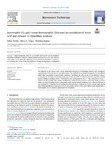Autotrophic (C₁-Gas) Versus Heterotrophic (Fructose) Accumulation of Acetic Acid and Ethanol in Clostridium Aceticum

Use este enlace para citar
http://hdl.handle.net/2183/28486
Excepto si se señala otra cosa, la licencia del ítem se describe como Atribución-NoComercial-SinDerivadas 4.0 Iinternacional
Colecciones
- Investigación (FCIE) [1228]
Metadatos
Mostrar el registro completo del ítemTítulo
Autotrophic (C₁-Gas) Versus Heterotrophic (Fructose) Accumulation of Acetic Acid and Ethanol in Clostridium AceticumFecha
2021-07-03Cita bibliográfica
Arslan, K., Veiga, M.C., Kennes, C., 2021. Autotrophic (C₁-Gas) versus heterotrophic (fructose) accumulation of acetic acid and ethanol in Clostridium aceticum. Bioresour. Technol. 337, 125485. doi:10.1016/j.biortech.2021.125485
Resumen
[Abstract] The influence of the carbon source on the metabolism and growth of Clostridium aceticum was investigated, supplying either CO or fructose as sole carbon source. The acid and solvent production patterns were determined under either autotrophic or heterotrophic conditions, elucidating the effect of pH on the substrate's bioconversion pattern. The highest maximum specific growth rate was observed with CO, under the organism's optimal growth conditions, reaching 0.052 h⁻¹ and an acetic acid concentration of 18 g·L⁻¹. The production of 4.4 g·L⁻¹ ethanol was also possible, after medium acidification, during CO bioconversion. Conversely, formic acid inhibition was observed during fructose fermentation under optimal growth conditions. In the latter experiments, it was not possible to stimulate solvent production when growing C. aceticum on fructose, despite applying the same medium acidification strategy as with CO, showing the selective effect of the carbon source (autotrophic vs heterotrophic) on the metabolic pattern and solventogenesis.
Palabras clave
Carbon monoxide
Carbon dioxide
Solventogenesis
Syngas
Wood-Ljungdahl pathway
Carbon dioxide
Solventogenesis
Syngas
Wood-Ljungdahl pathway
Descripción
Financiado para publicación en acceso aberto: Universidade da Coruña/CISUG
Versión del editor
Derechos
Atribución-NoComercial-SinDerivadas 4.0 Iinternacional
ISSN
0960-8524






